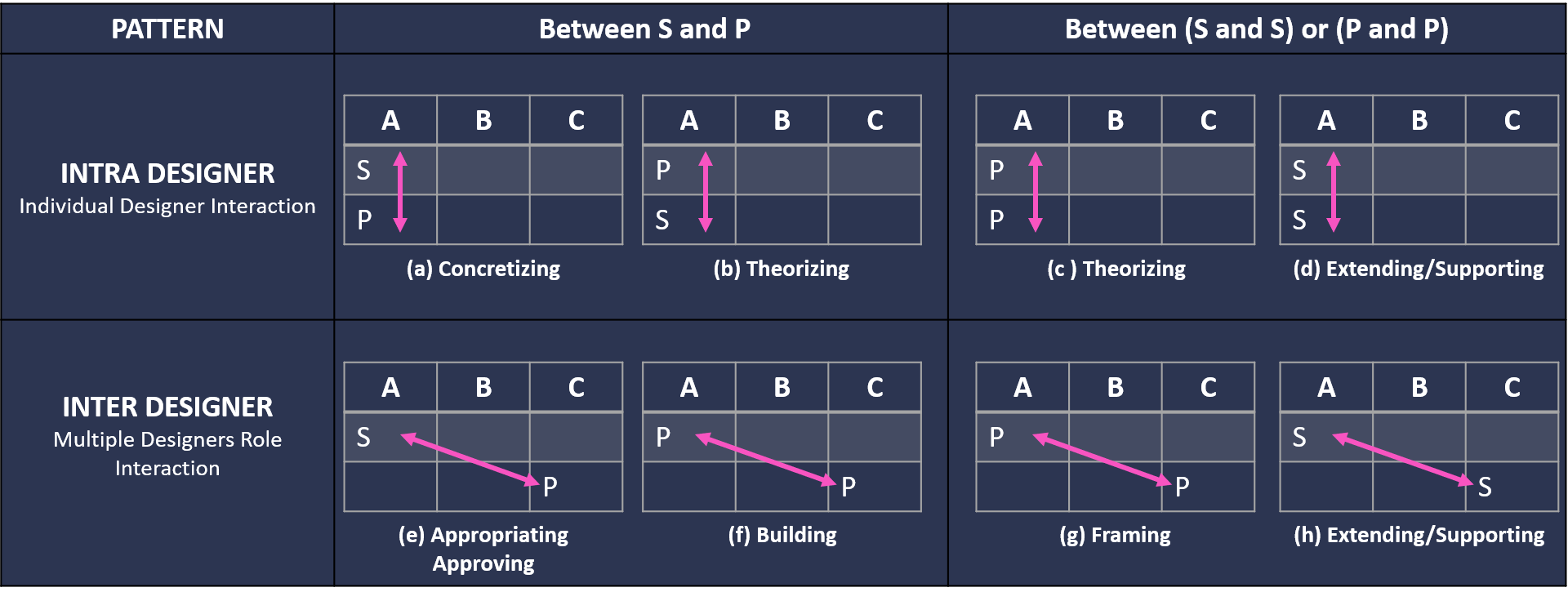Design Theory and Co-design
Decisive Constraints. Co-evolution. Schema | Design Theory Perspective
What is exactly happening in design theory to describe the dark or evil designing aspect in HCI/ design? What is happening in the background to explain how method developers or practitioners are building their conceptual knowledge around design or ethics?
Design activity is a practice-oriented, value-laden, and a highly reflective activity. This perspective of my research aimed to dig deeper into the background of what is happening with designers, method developers, and research-through-design efforts to describe various design theory concepts.
Across multiple studies, presented in my research portfolio, I always had a spin to describe and investigate the “meta” part of what might be happening to the empirical outcomes presented in my work. I leverage on using many design theory concepts to describe these such as:
Using Dorst’s Co-evolution of Problem and Solution space theoretical concept, a sequence analysis uncovered co-evolution of evil solutions supported through the collaboration defining “patterns of value-laden co-evolution” {C8}.
Using Biskjaer and Halskov framework of decisive constraints, a thematic analysis of interviews with ethics-focused method developers revealed various constraints used in designing methods; treating designing of methods as a design process {J4}.
Using Nelson and Stolterman’s definition of Schemas, a research-through-design reflective practice led to the development of schemas for design, development, and description of co-design activities {a contribution of my Dissertation}.
Using Zimmerman’s Research-through Design reflective practice and Löwgren’s definition on Intermediate-level Knowledge, a co/auto-ethnography of development of two co-design workshops led to listing four facets and three roles involved in framing co-design as a designerly practice {Manuscript In Review}.
Co-Evolving Towards Evil Design Outcomes: Mapping Problem and Solution Process Moves
Creative outcomes require designers to continuously frame the problem space and generate solutions, resulting in the co-evolution of problem and solution. Little work has addressed the value dimensions of design activity with regard to this co-evolutionary process and the role of the designer in acting upon specific and value-laden framings and/or solutions. In this paper, we identify how triads of student designers from user experience (UX) and industrial engineering (IE) disciplines frame the problem space and generate solutions, foregrounding the ethical character of their judgments in response to an ethically-nuanced design task. Using sequence analysis to analyze the lab protocol data, we describe the frequency and interconnectedness of process moves that lead the design team towards unethical outcomes. Based on our findings, we call for additional attention to ethical dimensions of problem-solution co-evolution, and identify key interaction patterns among designers that lead towards unethical outcomes.
In this paper, I leveraged on the design theoretical concept of co-evolution to describe the propagation of evil outcomes among a group of designers.
Co-Evolving Towards Evil Design Outcomes: Mapping Problem and Solution Process Moves
There are many different forms of design knowledge that guide and shape a designer’s ability to act and realize potential realities. Methods and schemas are examples of design knowledge commonly used by design researchers and designers alike. In this pictorial, we explore, engage, and describe the role of schemas as tools that can support design researchers in formulating methods to support design action, with our framing of method design specifically focused on ethical design complexity. We present four ways to engage with schema: 1) Systems to operationalize complex design constructs such as ethical design complexity through the A.E.I.O.YOU schema; 2) Classifiers to map existing methods and identify the possibility for new methods through descriptive semantic differentials; 3) Tools that enable the creation of methods that relate to one or more elements of the schema through creative departures from research to design; and 4) Interactive channels to playfully engage potential and new opportunities through schema interactivity.
In this WIP pictorial, I explored the concept of Design Schemas to represent their use in a designer’s work and how they can be used as thinking and representational tools.

